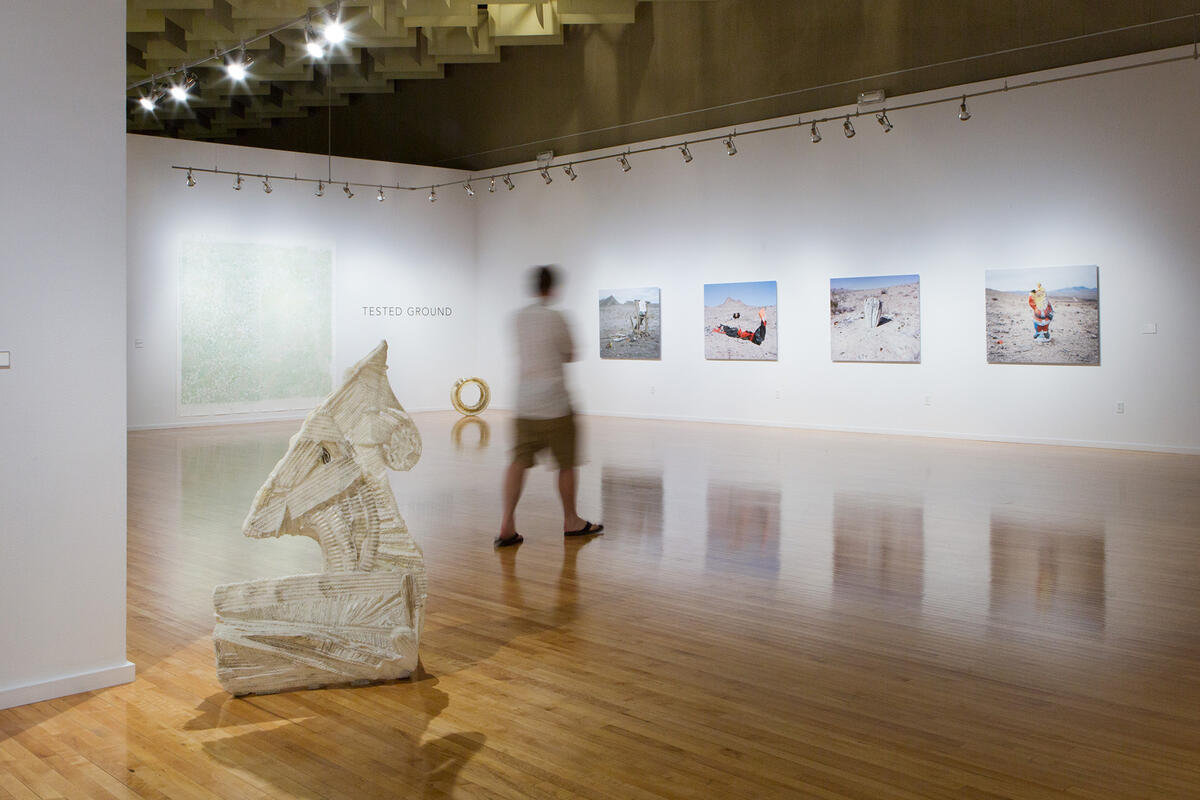“My eye goes to the horizon, and it’s trash all the way back.”
Tara Pike, UNLV’s recycling manager and sustainability coordinator, is looking at photographs by Alexa Hoyer in the Marjorie Barrick Museum of Art’s new exhibition, Tested Ground.
Hoyer, a German New Yorker, regularly visits the shooting ranges around Las Vegas to photograph the strange and unpredictable objects that people take out to the desert to use for target practice. Their totem-like forms cover several walls at the museum. Pike examines a portrait of a blasted Santa Claus decoration. In another picture, she marvels at a pineapple propped against a wooden strut, its leaves partly shredded by bullets.
“Someone could have eaten that,” she says. “People are starving.”
She has come at the invitation of the Barrick’s interim director, Alisha Kerlin, to brainstorm new ways to connect visitors with the Tested Ground exhibition. The artists featured have been inspired by debris, by hidden pollution under innocent surfaces, and by the things people leave behind. Most of them have a relationship with the desert landscape. An accompanying show in the Barrick’s West Gallery, Play On, Gary, Play On, has been built around the older objects in the museum’s collection — rusty lanterns, lithic flakes, buttons — all donated by local families such as the Rockwell ranchers.
Kerlin sees the beauty in the works. Yet she acknowledges their darker side. The bullet casings that cover Hoyer’s desert photographs with spots of color are lovely to look at, but in real life “those things don’t go away,” she says.
“Not like a banana peel,” agrees Pike, and the conversation turns to the speed at which bananas break down under desert conditions.
In New York State, where Pike was raised, open space was comparatively scarce, and cities could be stricter about recycling and trash collection. She remembers how collection companies charged to pick up a discarded couch. But in Clark County the service is free, lest people avoid payment by abandoning their old furniture in the fragile desert wilderness.
Pike is frustrated. “We need to teach kids stewardship.”
She wants parents to talk to children about the consequences of littering and waste. She suggests asking about what it means to throw something away. Where does it go? What is it made of? Can it be recycled or will it stay in the environment for decades? If you smash that toy, what happens to the pieces? Such questions spark conversations with her own 9-year-old son. “It’s about explaining to kids why you can’t destroy things.”
Now Kerlin wonders if the museum can inspire such a conversation around the artwork in Tested Ground. And can they do it without making the exhibition feel like a lecture? This is art, after all. It needs to be enjoyed. Can Pike help them strike that balance?
They walk together into the center gallery where Jenny Odell’s Bureau of Suspended Objects is on display.
Odell, a San Francisco artist, rescued objects from her local dump and researched their contexts, documenting everything for visitors to explore. People can view the history of a discarded VHS tape or a stuffed owl. Simply by interacting with the installation as the artist intended, the visitors — adults and children alike — are sharpening their appreciation of context. The object you throw away is not solely a piece of trash — it is many other things as well. This awareness seems valuable, and it can be achieved without lecturing.
Or what about the work of Andreana Donahue, who uses reclaimed denim in her quilt-based art? Donahue is scheduled to run fabric and quilting workshops at the Barrick’s upcoming Arts and Culture Community Day on June 16th. Is this an opportunity to remind participants about the pleasure of finding new uses for old clothes?
“I’m weird like these artists,” Pike says after they have viewed the exhibition.
Her work in recycling has made her think deeply about objects in her environment. Looking into trashcans, she sees potential. Like the artists, she thinks about things that can be reformed. Like the artists, she has a practice that makes her mindful. Examining art can help to train people in this kind of intelligent curiosity. She hopes her son will grow up to see the world the same way.



